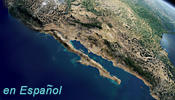![[Ocean Oasis Conservation]](images/bnr-conservation.gif)

![[Ocean Oasis Conservation]](images/bnr-conservation.gif) |  |
|
|
Concern for the protection of the islands inside this bay was fueled by members of the local ejido (rural community) Tierra y Libertad, especially the late Antero Díaz and his family, in collaboration with several American researchers. In the early 1970s Antonio Reséndiz came to Bahía de los Angeles to start a small program devoted to sea turtle research, with the help of Grant Bartlett of the Laboratory of Comparative Biochemistry in San Diego. Reséndiz's work was not limited to sea turtles; he collaborated extensively with almost all researchers that arrived in Bahía de los Angeles, and founded Campo Archelon, a small research center, with the support of his wife Betty. Since 1985, the center developed into a focal point for local conservation efforts in the bay area. Reséndiz is the current president of the ejido Tierra y Libertad. 
In 1988 the efforts of residents led by Carolina Espinoza culminated in the construction of the local Museum of Natural History and Culture. The museum has functioned as an information center about the ecological importance of the islands, and the natural and cultural history of the area. It has also provided environmental education opportunities for the local people. The proximity of Bahía de los Angeles to southern California, and its 16 small islands in well protected waters, make the area an ideal place for conservation and low impact visits. The growth in human use of the bay and the impacts on the islands prompted a binational group of researchers, governmental resource managers, and key local people to draft a management plan for the islands (Bourillón and Tershy 1997). A prioritized set of actions was proposed, which involved installing signs on the common landing and camping sites on the islands, defining and delimiting hiking trails, and starting an information, orientation, and registration system for island visitors. With economic support from a U.S. Fish and Wildlife Service grant under a joint program with the Instituto Nacional de Ecología (National Institute of Ecology of the Mexican Government), and with the support of Dan Anderson and the late Gary Polis, a group of members of the ejido established a committee in 1998 to fully implement the plan (Jiménez et al. 1999). The plan has shown how the active participation and involvement of a local community can effectively increase local conservation through simple, low cost management actions for island conservation.
Continue to |
|
Text adapted from the conservation chapter of the book Island Biogeography in the Sea of Cortés, a forthcoming volume edited by Ted Case, Martin Cody, and Exequiel Ezcurra. The chapter was authored by Luis Bourillon, Antonio Cantú, Exequiel Ezcurra, María Elena Martínez, and Alejandro Robles. |
Photograph by Bradford Hollingsworth
Conservation | Site Index | Ocean Oasis
San Diego Natural History Museum & PRONATURA
© 2000 CinemaCorp of the Californias